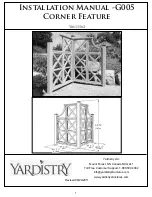
Pub# OM22-iScan EC-OM
6-5
Procedure #4: Diagnosing and Correcting EC Signal Problems.
Figure 4-1.
Electrode Functions-
Each coulter electrode is part of a pair, and each pair has a distinct function.
On an iScan:
Coulters 2 & 3 are the receptors
—they measure voltage drop.
Coulters 1 & 4
are the “charged” coulters that inject the current into the soil. If you are getting no (or
intermittent) readings -- continuity to one of these two coulter-electrodes is likely the cause.
If the continuity ohm test indicates a problem on a channel, you will need to determine where the
interruption is located. Listed below are detailed instructions on how to determine exactly where a
continuity or isolation problem is located:
A. Testing Cable and Wiring continuity:
1. Once a high resistance reading (poor continuity) on a channel is confirmed, determine whether the
problem is in the wiring or in the coulter-electrode. To test all cable and wiring, place one ohmmeter
lead in the Test Box terminal pin for that channel and the other on the corresponding electrode wire
terminal bolt (Figure 4-2). Repeat process on all electrodes.
Figure 4-2.
2. If you see <2 ohms on all, the cable is likely ok; test the coulter electrodes as explained in B below.
Electrode #1
Back side of
main iScan
member
Electrode #2
Front side of
main iScan
member
Electrode #3
Top side of
rear shank
Electrode #4
Underneath
closing
wheel mount












































